Analysis of Amazon's Innovation Strategy through Design Thinking
VerifiedAdded on 2022/12/20
|9
|2550
|46
Report
AI Summary
This report provides a comprehensive analysis of Amazon's innovation strategy, with a specific focus on its application of design thinking. It explores how Amazon has leveraged design thinking to enhance customer experiences, optimize its supply chain, and develop new services like Amazon Web Services and Amazon Alexa. The report delves into the concept of design thinking, outlining its five key stages: empathize, define, ideate, prototype, and test. It further examines value creation and capture, innovative capabilities, and strategic alignment within Amazon's innovation framework. A SWOT analysis is included, highlighting the company's strengths, opportunities, and potential threats. The report concludes with recommendations for managing objectives and organizational structure to foster innovation and drive business success. References to relevant academic sources are also provided throughout the report.

1
Innovation strategy
Innovation strategy
Paraphrase This Document
Need a fresh take? Get an instant paraphrase of this document with our AI Paraphraser
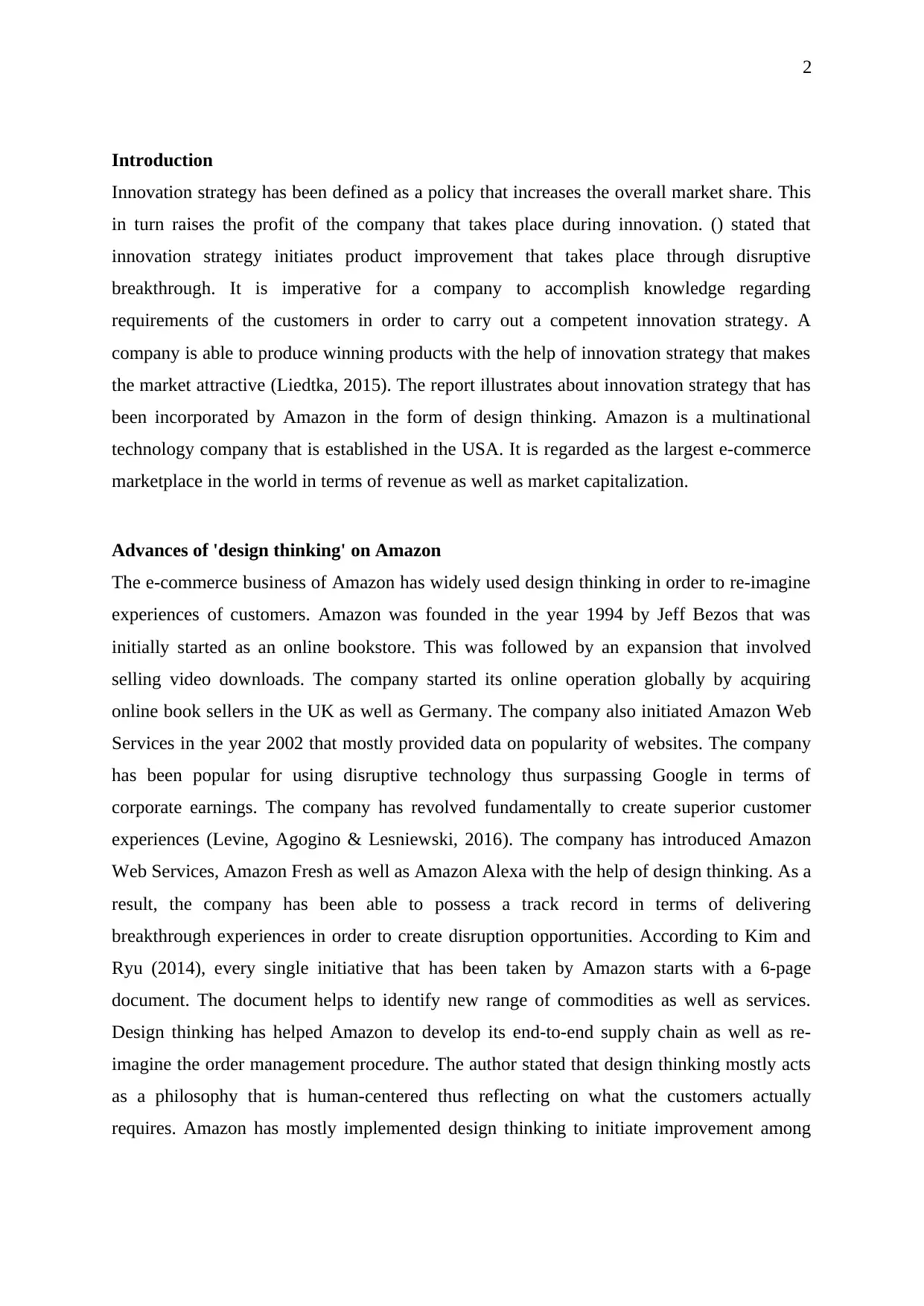
2
Introduction
Innovation strategy has been defined as a policy that increases the overall market share. This
in turn raises the profit of the company that takes place during innovation. () stated that
innovation strategy initiates product improvement that takes place through disruptive
breakthrough. It is imperative for a company to accomplish knowledge regarding
requirements of the customers in order to carry out a competent innovation strategy. A
company is able to produce winning products with the help of innovation strategy that makes
the market attractive (Liedtka, 2015). The report illustrates about innovation strategy that has
been incorporated by Amazon in the form of design thinking. Amazon is a multinational
technology company that is established in the USA. It is regarded as the largest e-commerce
marketplace in the world in terms of revenue as well as market capitalization.
Advances of 'design thinking' on Amazon
The e-commerce business of Amazon has widely used design thinking in order to re-imagine
experiences of customers. Amazon was founded in the year 1994 by Jeff Bezos that was
initially started as an online bookstore. This was followed by an expansion that involved
selling video downloads. The company started its online operation globally by acquiring
online book sellers in the UK as well as Germany. The company also initiated Amazon Web
Services in the year 2002 that mostly provided data on popularity of websites. The company
has been popular for using disruptive technology thus surpassing Google in terms of
corporate earnings. The company has revolved fundamentally to create superior customer
experiences (Levine, Agogino & Lesniewski, 2016). The company has introduced Amazon
Web Services, Amazon Fresh as well as Amazon Alexa with the help of design thinking. As a
result, the company has been able to possess a track record in terms of delivering
breakthrough experiences in order to create disruption opportunities. According to Kim and
Ryu (2014), every single initiative that has been taken by Amazon starts with a 6-page
document. The document helps to identify new range of commodities as well as services.
Design thinking has helped Amazon to develop its end-to-end supply chain as well as re-
imagine the order management procedure. The author stated that design thinking mostly acts
as a philosophy that is human-centered thus reflecting on what the customers actually
requires. Amazon has mostly implemented design thinking to initiate improvement among
Introduction
Innovation strategy has been defined as a policy that increases the overall market share. This
in turn raises the profit of the company that takes place during innovation. () stated that
innovation strategy initiates product improvement that takes place through disruptive
breakthrough. It is imperative for a company to accomplish knowledge regarding
requirements of the customers in order to carry out a competent innovation strategy. A
company is able to produce winning products with the help of innovation strategy that makes
the market attractive (Liedtka, 2015). The report illustrates about innovation strategy that has
been incorporated by Amazon in the form of design thinking. Amazon is a multinational
technology company that is established in the USA. It is regarded as the largest e-commerce
marketplace in the world in terms of revenue as well as market capitalization.
Advances of 'design thinking' on Amazon
The e-commerce business of Amazon has widely used design thinking in order to re-imagine
experiences of customers. Amazon was founded in the year 1994 by Jeff Bezos that was
initially started as an online bookstore. This was followed by an expansion that involved
selling video downloads. The company started its online operation globally by acquiring
online book sellers in the UK as well as Germany. The company also initiated Amazon Web
Services in the year 2002 that mostly provided data on popularity of websites. The company
has been popular for using disruptive technology thus surpassing Google in terms of
corporate earnings. The company has revolved fundamentally to create superior customer
experiences (Levine, Agogino & Lesniewski, 2016). The company has introduced Amazon
Web Services, Amazon Fresh as well as Amazon Alexa with the help of design thinking. As a
result, the company has been able to possess a track record in terms of delivering
breakthrough experiences in order to create disruption opportunities. According to Kim and
Ryu (2014), every single initiative that has been taken by Amazon starts with a 6-page
document. The document helps to identify new range of commodities as well as services.
Design thinking has helped Amazon to develop its end-to-end supply chain as well as re-
imagine the order management procedure. The author stated that design thinking mostly acts
as a philosophy that is human-centered thus reflecting on what the customers actually
requires. Amazon has mostly implemented design thinking to initiate improvement among
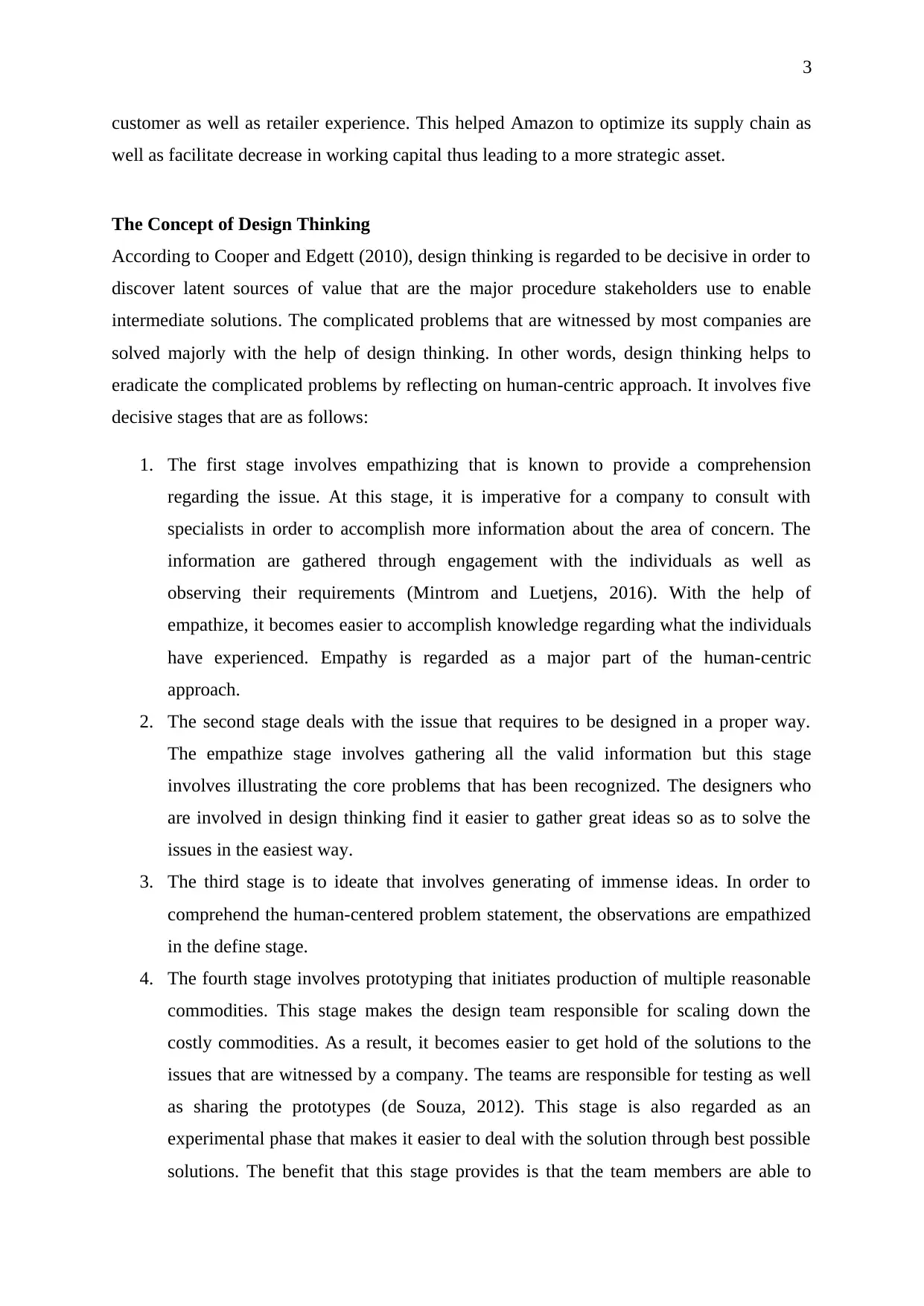
3
customer as well as retailer experience. This helped Amazon to optimize its supply chain as
well as facilitate decrease in working capital thus leading to a more strategic asset.
The Concept of Design Thinking
According to Cooper and Edgett (2010), design thinking is regarded to be decisive in order to
discover latent sources of value that are the major procedure stakeholders use to enable
intermediate solutions. The complicated problems that are witnessed by most companies are
solved majorly with the help of design thinking. In other words, design thinking helps to
eradicate the complicated problems by reflecting on human-centric approach. It involves five
decisive stages that are as follows:
1. The first stage involves empathizing that is known to provide a comprehension
regarding the issue. At this stage, it is imperative for a company to consult with
specialists in order to accomplish more information about the area of concern. The
information are gathered through engagement with the individuals as well as
observing their requirements (Mintrom and Luetjens, 2016). With the help of
empathize, it becomes easier to accomplish knowledge regarding what the individuals
have experienced. Empathy is regarded as a major part of the human-centric
approach.
2. The second stage deals with the issue that requires to be designed in a proper way.
The empathize stage involves gathering all the valid information but this stage
involves illustrating the core problems that has been recognized. The designers who
are involved in design thinking find it easier to gather great ideas so as to solve the
issues in the easiest way.
3. The third stage is to ideate that involves generating of immense ideas. In order to
comprehend the human-centered problem statement, the observations are empathized
in the define stage.
4. The fourth stage involves prototyping that initiates production of multiple reasonable
commodities. This stage makes the design team responsible for scaling down the
costly commodities. As a result, it becomes easier to get hold of the solutions to the
issues that are witnessed by a company. The teams are responsible for testing as well
as sharing the prototypes (de Souza, 2012). This stage is also regarded as an
experimental phase that makes it easier to deal with the solution through best possible
solutions. The benefit that this stage provides is that the team members are able to
customer as well as retailer experience. This helped Amazon to optimize its supply chain as
well as facilitate decrease in working capital thus leading to a more strategic asset.
The Concept of Design Thinking
According to Cooper and Edgett (2010), design thinking is regarded to be decisive in order to
discover latent sources of value that are the major procedure stakeholders use to enable
intermediate solutions. The complicated problems that are witnessed by most companies are
solved majorly with the help of design thinking. In other words, design thinking helps to
eradicate the complicated problems by reflecting on human-centric approach. It involves five
decisive stages that are as follows:
1. The first stage involves empathizing that is known to provide a comprehension
regarding the issue. At this stage, it is imperative for a company to consult with
specialists in order to accomplish more information about the area of concern. The
information are gathered through engagement with the individuals as well as
observing their requirements (Mintrom and Luetjens, 2016). With the help of
empathize, it becomes easier to accomplish knowledge regarding what the individuals
have experienced. Empathy is regarded as a major part of the human-centric
approach.
2. The second stage deals with the issue that requires to be designed in a proper way.
The empathize stage involves gathering all the valid information but this stage
involves illustrating the core problems that has been recognized. The designers who
are involved in design thinking find it easier to gather great ideas so as to solve the
issues in the easiest way.
3. The third stage is to ideate that involves generating of immense ideas. In order to
comprehend the human-centered problem statement, the observations are empathized
in the define stage.
4. The fourth stage involves prototyping that initiates production of multiple reasonable
commodities. This stage makes the design team responsible for scaling down the
costly commodities. As a result, it becomes easier to get hold of the solutions to the
issues that are witnessed by a company. The teams are responsible for testing as well
as sharing the prototypes (de Souza, 2012). This stage is also regarded as an
experimental phase that makes it easier to deal with the solution through best possible
solutions. The benefit that this stage provides is that the team members are able to
⊘ This is a preview!⊘
Do you want full access?
Subscribe today to unlock all pages.

Trusted by 1+ million students worldwide
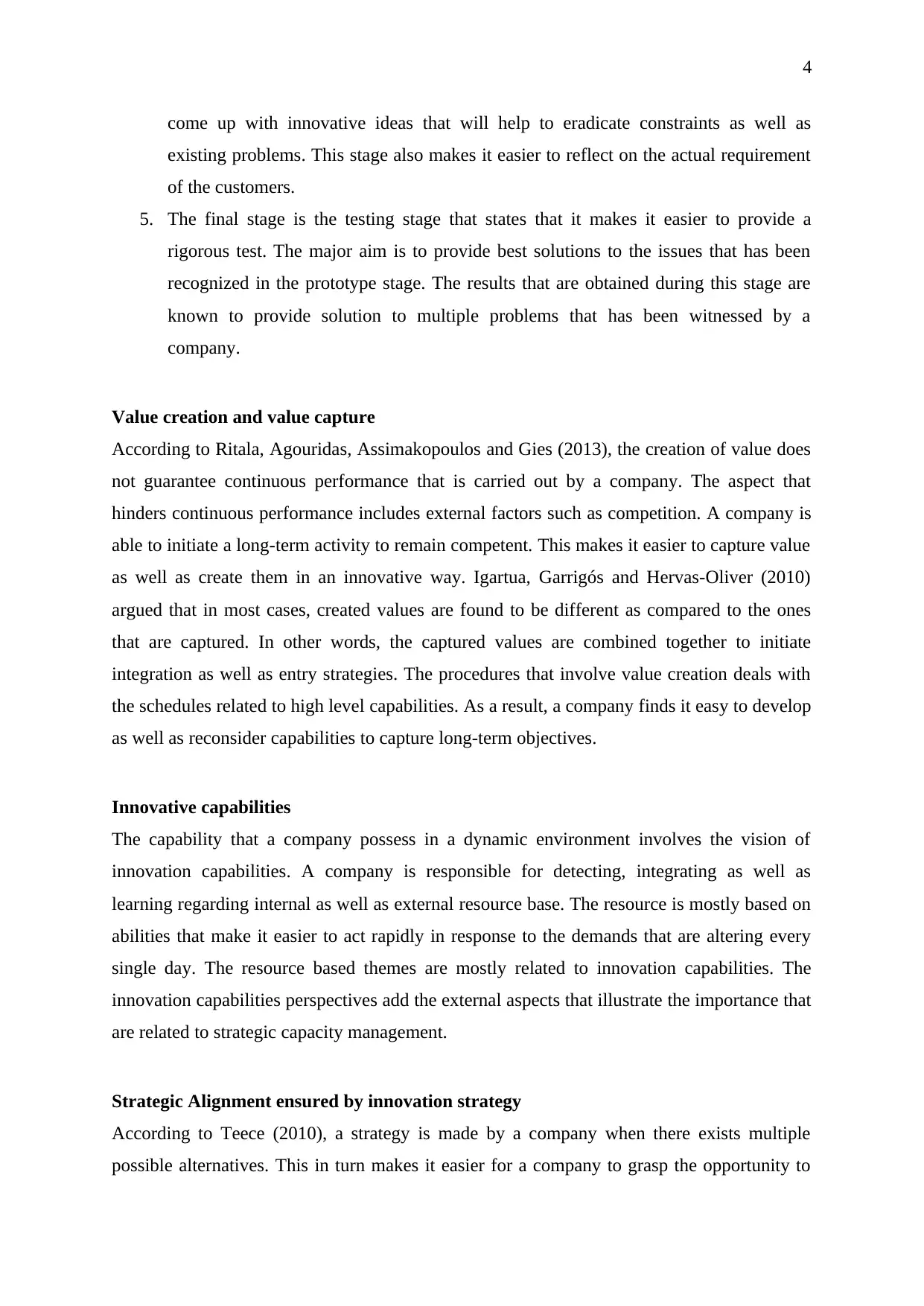
4
come up with innovative ideas that will help to eradicate constraints as well as
existing problems. This stage also makes it easier to reflect on the actual requirement
of the customers.
5. The final stage is the testing stage that states that it makes it easier to provide a
rigorous test. The major aim is to provide best solutions to the issues that has been
recognized in the prototype stage. The results that are obtained during this stage are
known to provide solution to multiple problems that has been witnessed by a
company.
Value creation and value capture
According to Ritala, Agouridas, Assimakopoulos and Gies (2013), the creation of value does
not guarantee continuous performance that is carried out by a company. The aspect that
hinders continuous performance includes external factors such as competition. A company is
able to initiate a long-term activity to remain competent. This makes it easier to capture value
as well as create them in an innovative way. Igartua, Garrigós and Hervas-Oliver (2010)
argued that in most cases, created values are found to be different as compared to the ones
that are captured. In other words, the captured values are combined together to initiate
integration as well as entry strategies. The procedures that involve value creation deals with
the schedules related to high level capabilities. As a result, a company finds it easy to develop
as well as reconsider capabilities to capture long-term objectives.
Innovative capabilities
The capability that a company possess in a dynamic environment involves the vision of
innovation capabilities. A company is responsible for detecting, integrating as well as
learning regarding internal as well as external resource base. The resource is mostly based on
abilities that make it easier to act rapidly in response to the demands that are altering every
single day. The resource based themes are mostly related to innovation capabilities. The
innovation capabilities perspectives add the external aspects that illustrate the importance that
are related to strategic capacity management.
Strategic Alignment ensured by innovation strategy
According to Teece (2010), a strategy is made by a company when there exists multiple
possible alternatives. This in turn makes it easier for a company to grasp the opportunity to
come up with innovative ideas that will help to eradicate constraints as well as
existing problems. This stage also makes it easier to reflect on the actual requirement
of the customers.
5. The final stage is the testing stage that states that it makes it easier to provide a
rigorous test. The major aim is to provide best solutions to the issues that has been
recognized in the prototype stage. The results that are obtained during this stage are
known to provide solution to multiple problems that has been witnessed by a
company.
Value creation and value capture
According to Ritala, Agouridas, Assimakopoulos and Gies (2013), the creation of value does
not guarantee continuous performance that is carried out by a company. The aspect that
hinders continuous performance includes external factors such as competition. A company is
able to initiate a long-term activity to remain competent. This makes it easier to capture value
as well as create them in an innovative way. Igartua, Garrigós and Hervas-Oliver (2010)
argued that in most cases, created values are found to be different as compared to the ones
that are captured. In other words, the captured values are combined together to initiate
integration as well as entry strategies. The procedures that involve value creation deals with
the schedules related to high level capabilities. As a result, a company finds it easy to develop
as well as reconsider capabilities to capture long-term objectives.
Innovative capabilities
The capability that a company possess in a dynamic environment involves the vision of
innovation capabilities. A company is responsible for detecting, integrating as well as
learning regarding internal as well as external resource base. The resource is mostly based on
abilities that make it easier to act rapidly in response to the demands that are altering every
single day. The resource based themes are mostly related to innovation capabilities. The
innovation capabilities perspectives add the external aspects that illustrate the importance that
are related to strategic capacity management.
Strategic Alignment ensured by innovation strategy
According to Teece (2010), a strategy is made by a company when there exists multiple
possible alternatives. This in turn makes it easier for a company to grasp the opportunity to
Paraphrase This Document
Need a fresh take? Get an instant paraphrase of this document with our AI Paraphraser
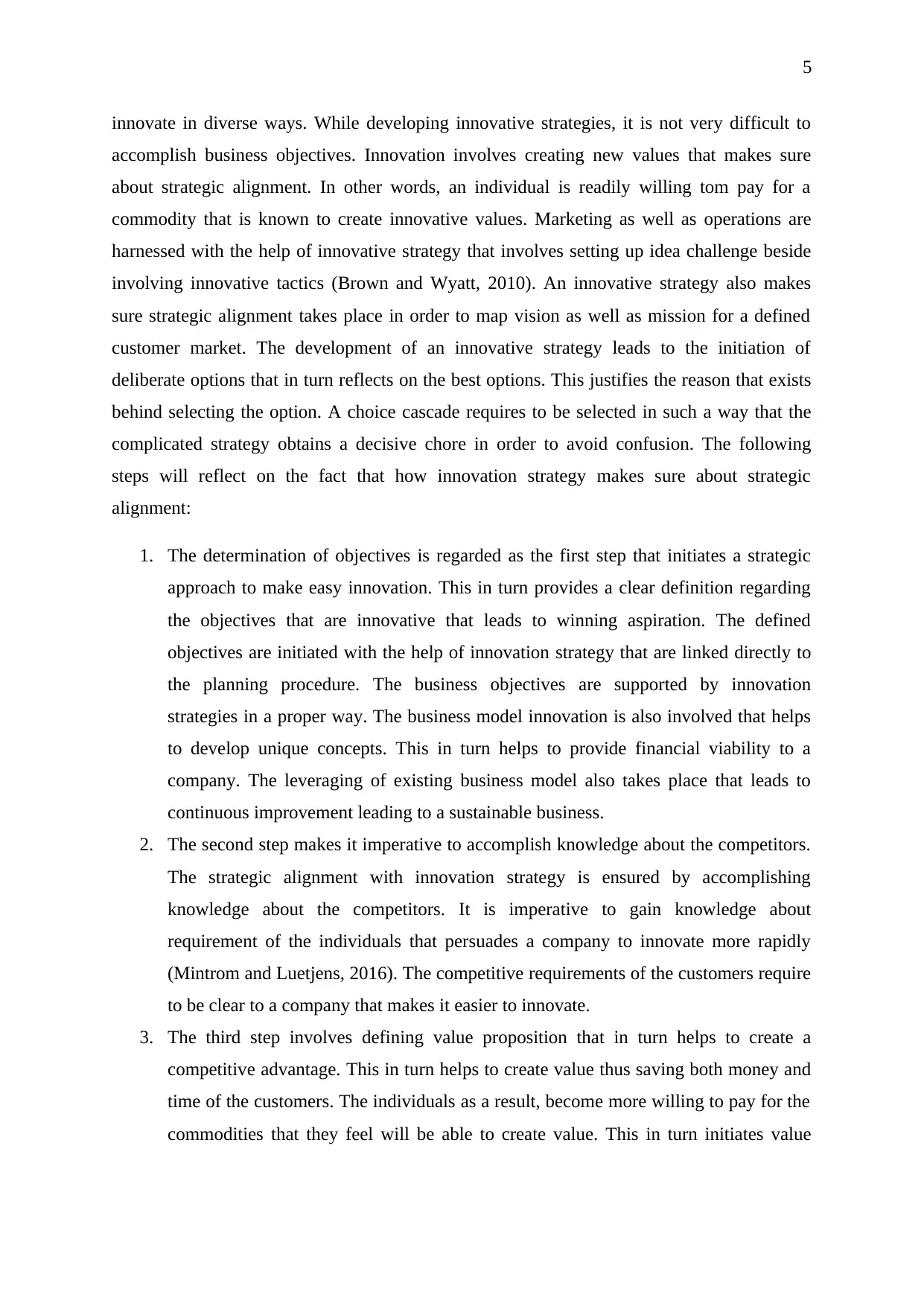
5
innovate in diverse ways. While developing innovative strategies, it is not very difficult to
accomplish business objectives. Innovation involves creating new values that makes sure
about strategic alignment. In other words, an individual is readily willing tom pay for a
commodity that is known to create innovative values. Marketing as well as operations are
harnessed with the help of innovative strategy that involves setting up idea challenge beside
involving innovative tactics (Brown and Wyatt, 2010). An innovative strategy also makes
sure strategic alignment takes place in order to map vision as well as mission for a defined
customer market. The development of an innovative strategy leads to the initiation of
deliberate options that in turn reflects on the best options. This justifies the reason that exists
behind selecting the option. A choice cascade requires to be selected in such a way that the
complicated strategy obtains a decisive chore in order to avoid confusion. The following
steps will reflect on the fact that how innovation strategy makes sure about strategic
alignment:
1. The determination of objectives is regarded as the first step that initiates a strategic
approach to make easy innovation. This in turn provides a clear definition regarding
the objectives that are innovative that leads to winning aspiration. The defined
objectives are initiated with the help of innovation strategy that are linked directly to
the planning procedure. The business objectives are supported by innovation
strategies in a proper way. The business model innovation is also involved that helps
to develop unique concepts. This in turn helps to provide financial viability to a
company. The leveraging of existing business model also takes place that leads to
continuous improvement leading to a sustainable business.
2. The second step makes it imperative to accomplish knowledge about the competitors.
The strategic alignment with innovation strategy is ensured by accomplishing
knowledge about the competitors. It is imperative to gain knowledge about
requirement of the individuals that persuades a company to innovate more rapidly
(Mintrom and Luetjens, 2016). The competitive requirements of the customers require
to be clear to a company that makes it easier to innovate.
3. The third step involves defining value proposition that in turn helps to create a
competitive advantage. This in turn helps to create value thus saving both money and
time of the customers. The individuals as a result, become more willing to pay for the
commodities that they feel will be able to create value. This in turn initiates value
innovate in diverse ways. While developing innovative strategies, it is not very difficult to
accomplish business objectives. Innovation involves creating new values that makes sure
about strategic alignment. In other words, an individual is readily willing tom pay for a
commodity that is known to create innovative values. Marketing as well as operations are
harnessed with the help of innovative strategy that involves setting up idea challenge beside
involving innovative tactics (Brown and Wyatt, 2010). An innovative strategy also makes
sure strategic alignment takes place in order to map vision as well as mission for a defined
customer market. The development of an innovative strategy leads to the initiation of
deliberate options that in turn reflects on the best options. This justifies the reason that exists
behind selecting the option. A choice cascade requires to be selected in such a way that the
complicated strategy obtains a decisive chore in order to avoid confusion. The following
steps will reflect on the fact that how innovation strategy makes sure about strategic
alignment:
1. The determination of objectives is regarded as the first step that initiates a strategic
approach to make easy innovation. This in turn provides a clear definition regarding
the objectives that are innovative that leads to winning aspiration. The defined
objectives are initiated with the help of innovation strategy that are linked directly to
the planning procedure. The business objectives are supported by innovation
strategies in a proper way. The business model innovation is also involved that helps
to develop unique concepts. This in turn helps to provide financial viability to a
company. The leveraging of existing business model also takes place that leads to
continuous improvement leading to a sustainable business.
2. The second step makes it imperative to accomplish knowledge about the competitors.
The strategic alignment with innovation strategy is ensured by accomplishing
knowledge about the competitors. It is imperative to gain knowledge about
requirement of the individuals that persuades a company to innovate more rapidly
(Mintrom and Luetjens, 2016). The competitive requirements of the customers require
to be clear to a company that makes it easier to innovate.
3. The third step involves defining value proposition that in turn helps to create a
competitive advantage. This in turn helps to create value thus saving both money and
time of the customers. The individuals as a result, become more willing to pay for the
commodities that they feel will be able to create value. This in turn initiates value
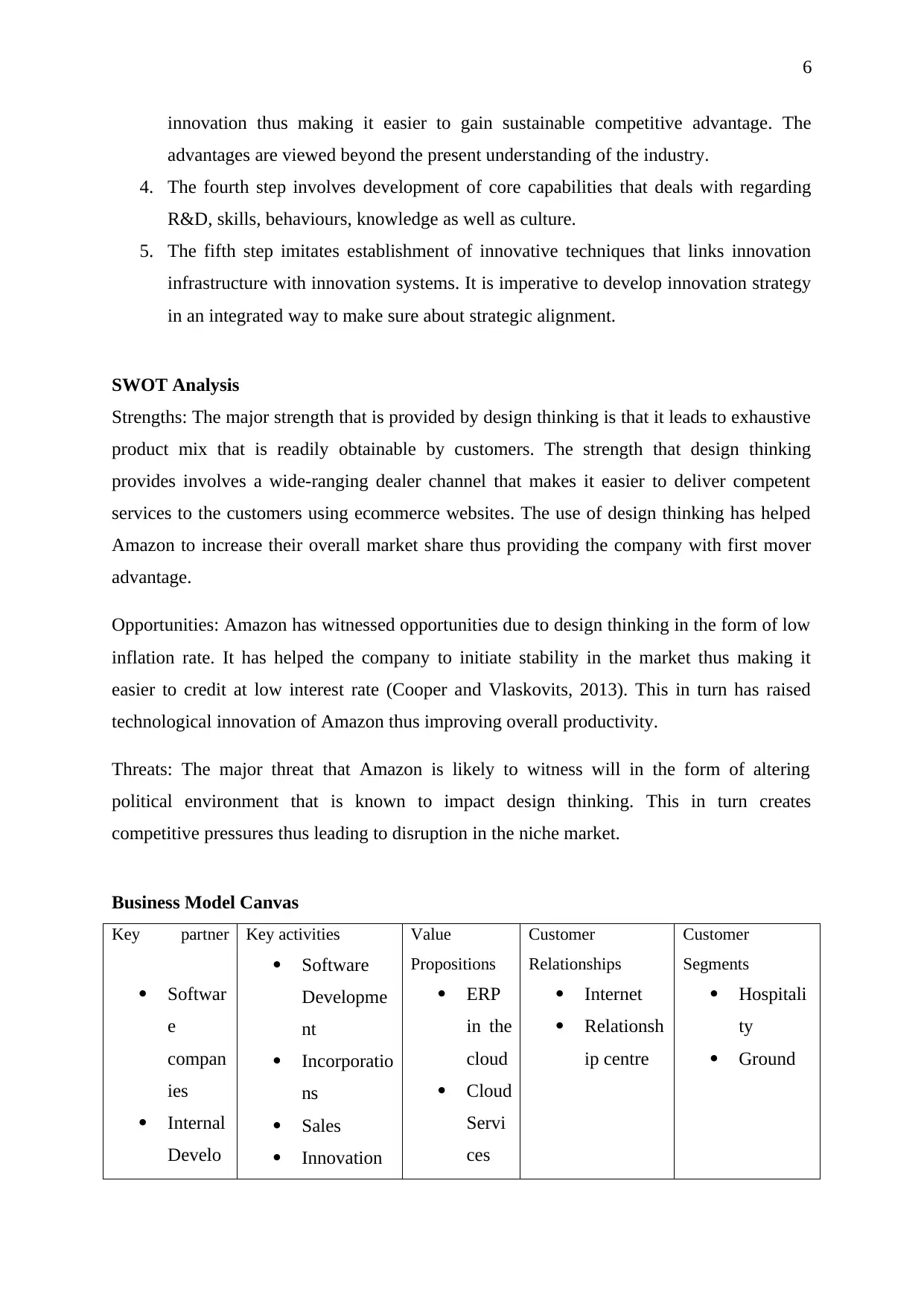
6
innovation thus making it easier to gain sustainable competitive advantage. The
advantages are viewed beyond the present understanding of the industry.
4. The fourth step involves development of core capabilities that deals with regarding
R&D, skills, behaviours, knowledge as well as culture.
5. The fifth step imitates establishment of innovative techniques that links innovation
infrastructure with innovation systems. It is imperative to develop innovation strategy
in an integrated way to make sure about strategic alignment.
SWOT Analysis
Strengths: The major strength that is provided by design thinking is that it leads to exhaustive
product mix that is readily obtainable by customers. The strength that design thinking
provides involves a wide-ranging dealer channel that makes it easier to deliver competent
services to the customers using ecommerce websites. The use of design thinking has helped
Amazon to increase their overall market share thus providing the company with first mover
advantage.
Opportunities: Amazon has witnessed opportunities due to design thinking in the form of low
inflation rate. It has helped the company to initiate stability in the market thus making it
easier to credit at low interest rate (Cooper and Vlaskovits, 2013). This in turn has raised
technological innovation of Amazon thus improving overall productivity.
Threats: The major threat that Amazon is likely to witness will in the form of altering
political environment that is known to impact design thinking. This in turn creates
competitive pressures thus leading to disruption in the niche market.
Business Model Canvas
Key partner
Softwar
e
compan
ies
Internal
Develo
Key activities
Software
Developme
nt
Incorporatio
ns
Sales
Innovation
Value
Propositions
ERP
in the
cloud
Cloud
Servi
ces
Customer
Relationships
Internet
Relationsh
ip centre
Customer
Segments
Hospitali
ty
Ground
innovation thus making it easier to gain sustainable competitive advantage. The
advantages are viewed beyond the present understanding of the industry.
4. The fourth step involves development of core capabilities that deals with regarding
R&D, skills, behaviours, knowledge as well as culture.
5. The fifth step imitates establishment of innovative techniques that links innovation
infrastructure with innovation systems. It is imperative to develop innovation strategy
in an integrated way to make sure about strategic alignment.
SWOT Analysis
Strengths: The major strength that is provided by design thinking is that it leads to exhaustive
product mix that is readily obtainable by customers. The strength that design thinking
provides involves a wide-ranging dealer channel that makes it easier to deliver competent
services to the customers using ecommerce websites. The use of design thinking has helped
Amazon to increase their overall market share thus providing the company with first mover
advantage.
Opportunities: Amazon has witnessed opportunities due to design thinking in the form of low
inflation rate. It has helped the company to initiate stability in the market thus making it
easier to credit at low interest rate (Cooper and Vlaskovits, 2013). This in turn has raised
technological innovation of Amazon thus improving overall productivity.
Threats: The major threat that Amazon is likely to witness will in the form of altering
political environment that is known to impact design thinking. This in turn creates
competitive pressures thus leading to disruption in the niche market.
Business Model Canvas
Key partner
Softwar
e
compan
ies
Internal
Develo
Key activities
Software
Developme
nt
Incorporatio
ns
Sales
Innovation
Value
Propositions
ERP
in the
cloud
Cloud
Servi
ces
Customer
Relationships
Internet
Relationsh
ip centre
Customer
Segments
Hospitali
ty
Ground
⊘ This is a preview!⊘
Do you want full access?
Subscribe today to unlock all pages.

Trusted by 1+ million students worldwide
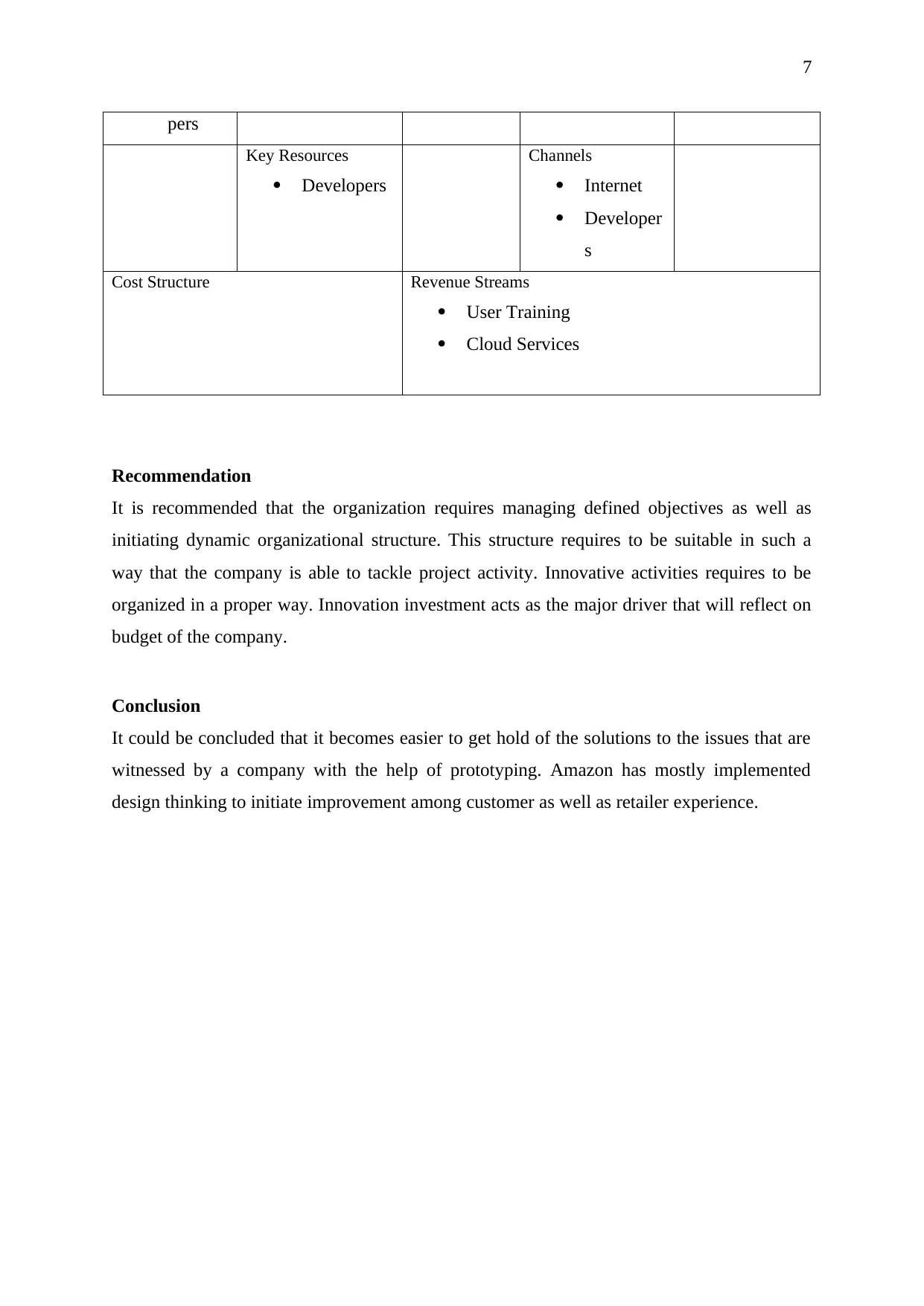
7
pers
Key Resources
Developers
Channels
Internet
Developer
s
Cost Structure Revenue Streams
User Training
Cloud Services
Recommendation
It is recommended that the organization requires managing defined objectives as well as
initiating dynamic organizational structure. This structure requires to be suitable in such a
way that the company is able to tackle project activity. Innovative activities requires to be
organized in a proper way. Innovation investment acts as the major driver that will reflect on
budget of the company.
Conclusion
It could be concluded that it becomes easier to get hold of the solutions to the issues that are
witnessed by a company with the help of prototyping. Amazon has mostly implemented
design thinking to initiate improvement among customer as well as retailer experience.
pers
Key Resources
Developers
Channels
Internet
Developer
s
Cost Structure Revenue Streams
User Training
Cloud Services
Recommendation
It is recommended that the organization requires managing defined objectives as well as
initiating dynamic organizational structure. This structure requires to be suitable in such a
way that the company is able to tackle project activity. Innovative activities requires to be
organized in a proper way. Innovation investment acts as the major driver that will reflect on
budget of the company.
Conclusion
It could be concluded that it becomes easier to get hold of the solutions to the issues that are
witnessed by a company with the help of prototyping. Amazon has mostly implemented
design thinking to initiate improvement among customer as well as retailer experience.
Paraphrase This Document
Need a fresh take? Get an instant paraphrase of this document with our AI Paraphraser
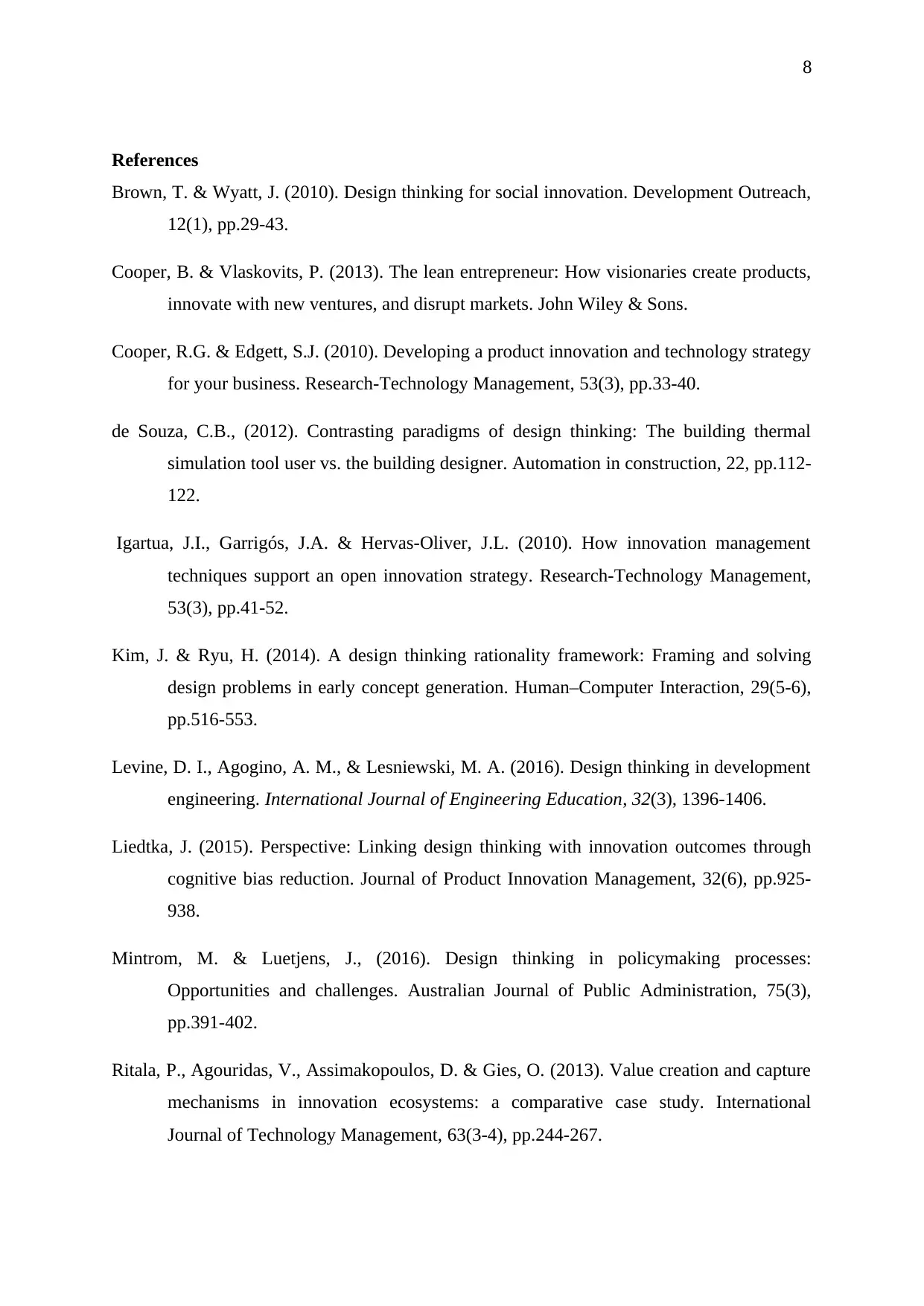
8
References
Brown, T. & Wyatt, J. (2010). Design thinking for social innovation. Development Outreach,
12(1), pp.29-43.
Cooper, B. & Vlaskovits, P. (2013). The lean entrepreneur: How visionaries create products,
innovate with new ventures, and disrupt markets. John Wiley & Sons.
Cooper, R.G. & Edgett, S.J. (2010). Developing a product innovation and technology strategy
for your business. Research-Technology Management, 53(3), pp.33-40.
de Souza, C.B., (2012). Contrasting paradigms of design thinking: The building thermal
simulation tool user vs. the building designer. Automation in construction, 22, pp.112-
122.
Igartua, J.I., Garrigós, J.A. & Hervas-Oliver, J.L. (2010). How innovation management
techniques support an open innovation strategy. Research-Technology Management,
53(3), pp.41-52.
Kim, J. & Ryu, H. (2014). A design thinking rationality framework: Framing and solving
design problems in early concept generation. Human–Computer Interaction, 29(5-6),
pp.516-553.
Levine, D. I., Agogino, A. M., & Lesniewski, M. A. (2016). Design thinking in development
engineering. International Journal of Engineering Education, 32(3), 1396-1406.
Liedtka, J. (2015). Perspective: Linking design thinking with innovation outcomes through
cognitive bias reduction. Journal of Product Innovation Management, 32(6), pp.925-
938.
Mintrom, M. & Luetjens, J., (2016). Design thinking in policymaking processes:
Opportunities and challenges. Australian Journal of Public Administration, 75(3),
pp.391-402.
Ritala, P., Agouridas, V., Assimakopoulos, D. & Gies, O. (2013). Value creation and capture
mechanisms in innovation ecosystems: a comparative case study. International
Journal of Technology Management, 63(3-4), pp.244-267.
References
Brown, T. & Wyatt, J. (2010). Design thinking for social innovation. Development Outreach,
12(1), pp.29-43.
Cooper, B. & Vlaskovits, P. (2013). The lean entrepreneur: How visionaries create products,
innovate with new ventures, and disrupt markets. John Wiley & Sons.
Cooper, R.G. & Edgett, S.J. (2010). Developing a product innovation and technology strategy
for your business. Research-Technology Management, 53(3), pp.33-40.
de Souza, C.B., (2012). Contrasting paradigms of design thinking: The building thermal
simulation tool user vs. the building designer. Automation in construction, 22, pp.112-
122.
Igartua, J.I., Garrigós, J.A. & Hervas-Oliver, J.L. (2010). How innovation management
techniques support an open innovation strategy. Research-Technology Management,
53(3), pp.41-52.
Kim, J. & Ryu, H. (2014). A design thinking rationality framework: Framing and solving
design problems in early concept generation. Human–Computer Interaction, 29(5-6),
pp.516-553.
Levine, D. I., Agogino, A. M., & Lesniewski, M. A. (2016). Design thinking in development
engineering. International Journal of Engineering Education, 32(3), 1396-1406.
Liedtka, J. (2015). Perspective: Linking design thinking with innovation outcomes through
cognitive bias reduction. Journal of Product Innovation Management, 32(6), pp.925-
938.
Mintrom, M. & Luetjens, J., (2016). Design thinking in policymaking processes:
Opportunities and challenges. Australian Journal of Public Administration, 75(3),
pp.391-402.
Ritala, P., Agouridas, V., Assimakopoulos, D. & Gies, O. (2013). Value creation and capture
mechanisms in innovation ecosystems: a comparative case study. International
Journal of Technology Management, 63(3-4), pp.244-267.

9
Teece, D.J. (2010). Business models, business strategy and innovation. Long range planning,
43(2-3), pp.172-194.
Teece, D.J. (2010). Business models, business strategy and innovation. Long range planning,
43(2-3), pp.172-194.
⊘ This is a preview!⊘
Do you want full access?
Subscribe today to unlock all pages.

Trusted by 1+ million students worldwide
1 out of 9
Related Documents
Your All-in-One AI-Powered Toolkit for Academic Success.
+13062052269
info@desklib.com
Available 24*7 on WhatsApp / Email
![[object Object]](/_next/static/media/star-bottom.7253800d.svg)
Unlock your academic potential
Copyright © 2020–2025 A2Z Services. All Rights Reserved. Developed and managed by ZUCOL.



